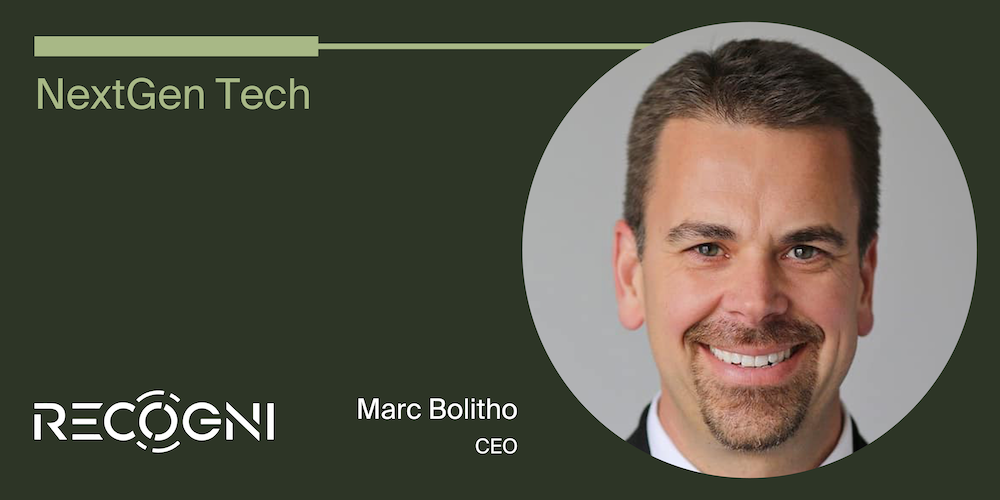NextGen Tech Leader: Recogni CEO Marc Bolitho
NextGen Tech Leader: Recogni CEO Marc Bolitho
Marc Bolitho is the CEO of Recogni, the leader in AI-based perception purpose-built for autonomous vehicles. He has 28 years of experience in automotive electronics. As the Senior Vice President of ZF Group, he was responsible for the ADAS business unit with $2B in annual revenue and a global team of 5,000.

Marc Bolitho is the CEO of Recogni, the leader in AI-based perception purpose-built for autonomous vehicles. He has 28 years of experience in automotive electronics. As the Senior Vice President of ZF Group, he was responsible for the ADAS business unit with $2B in annual revenue and a global team of 5,000.
What does Recogni focus on, tell us about your technology?
At Recogni, we’re trying to solve the problem of enabling autonomous driving in a safe and sustainable way. Others today don't have the processing capability that's required to process all the information coming in to make autonomous vehicles reliably safe. That's what we're enabling with our artificial intelligence processor.
The issue in autonomous driving is that you start to add the computation power to the vehicle’s operation which has large power implications for the vehicle, in particular with the range for electric vehicles. What we're able to do with the architecture Recogni has developed is to have very high compute capability for artificial intelligence processing, but at a very low level of power. This enables a longer electric vehicle range and lower cooling costs, providing a purpose-built solution for the mobility industry.
We're also working on this for adjacent markets, in addition to automotive. This same technology can be applied to the farming industry, the mining industry, the aircraft, and drone markets as well.
What is new about Recogni’s approach vs. your competitors?
What most others is use Graphics Processing Units (GPUs) for autonomous driving, processors which were originally meant for graphical processing in gaming. They are not built to be used like that because of the large power requirements. What our team has done is really looked at this again from a first principles approach and asked, "How do we get the largest compute at the lowest power?"
Those two never go hand in hand. When you increase the compute, you're always increasing the power. What we’ve created is a unique architecture and a very small device, which gives us fundamental advantages on chip size, power, and the amount of computing power we're able to offer. The smaller the device, the less cost there is going to be. That's important for customers. But the even bigger need our customers have is compute capability that is powerful, but also efficient - they need the capacity necessary to make autonomous vehicles safe, without becoming a drain on a battery in an electric vehicle. At Recogni, we’ve found that we can have 20% range increases over other solutions under certain driving scenarios.
What is the long-term vision for Recogni?
The long-term vision in the future for us is to be a competitive semiconductor company, one of the major players in the mobility space, and providing full system-on-chip capability. We believe we can provide full capability for the different levels of vehicle autonomy, up to level four autonomy which means the vehicle is completely self-piloted.
We also want to be able to have a processor that's available for the other adjacent markets that can benefit from this capability. My job is to help build out the company to be able to deliver into those various markets and scale our operations as we go forward.
How has the recent explosion of generative AI impacted Recogni?
With the explosion of ChatGPT a few months ago, a new market was absolutely created that wasn't there before, and it’s here to stay. The real issue we see going forward is that there will be billions of Generative AI users driving massive compute needs. The compute capability simply does not exist today to be able to serve all those users. It needs to be able to serve them in a very cost-effective way, but also in a sustainable way that's going to minimally impact the environment.
On the automotive side, we need a more powerful compute capability for artificial intelligence, and much lower power usage. Moving then to the data center, that use case will face the same challenges as well. There are big cooling costs in data centers. There is a lot of opportunity in the AI space, but more solutions need to be created for real, sustained transformation to happen.
What exciting things are happening in the business right now at Recogni?
We're seeing a lot of good traction from automotive customers who are very interested in our current and next generation products, which solve the problems for level two and level three autonomous driving. They're looking to add our current product to their existing architecture. The demand we're receiving from both the end high-volume vehicle manufacturers and other adjacent markets is very exciting. We’re in the process of finalizing the architecture for our next generation device, which will only open even more opportunities for us in months ahead.
Tell us a bit about your professional background?
I’ve spent 28 years in the automotive industry, working on the engineering side and the business side as well. My most recent role within automotive was at ZF, which is a top tier automotive supplier, one of the largest automotive suppliers in the world, based out of Germany. I was responsible for the Advanced Driver Assistance Systems business unit.
I was first introduced to Recogni while in this role, as we conducted an extensive search for next generation processors. As we reviewed the performance and power efficiency of several different products, Recogni had an off-the-charts performance. When the opportunity came up to join the team a few months later, I was very excited to jump at the chance to be a part of what the company is building. I've always loved entrepreneurial roles and the opportunity to take something from very early stages, help to move that through development into a product, and then bring it to market is very interesting to me.
How do you think an investor can best support an early-stage company like Recogni?
Our board members from the venture capital world have been an excellent support for me. They’ve advised me through aspects of the startup world that were new to me, such as fundraising, opening doors not only to potential investors, but other potential partners that can benefit our growth and improve our margins. The broad network they bring is unparalleled, and the guidance through the process has been very helpful to us.
How do you think about the resilience necessary to deal with the challenges startups face?
Resilience is really the right word. That's what I try to show to the team and discuss with them often – there are going to be ups and downs along the way, but you must have resilience. You need to keep pushing to keep the momentum up and bring a real tenacity to solving our everyday issues.
Tomorrow is always a new day. Something doesn't go well today, brush it off and take a fresh stab at it tomorrow. I think we've been doing that, and it’s been great to see our whole team embrace that mindset.
What advice would you give to other early-stage tech leaders?
In my view the most important piece to focus on first is your culture and team. You must have the right people in the right positions of course, but, more importantly, you need a culture that drives toward shared goals and effective teamwork. It’s imperative to remove any of the politics out of decisions and make sure everyone is driving towards a shared vision and common goals. There is no time to waste in a startup environment; the competition for resources and customers is fierce. It’s worth slowing down a bit to get on the same page, so you can move much more quickly and decisively as a unit.






